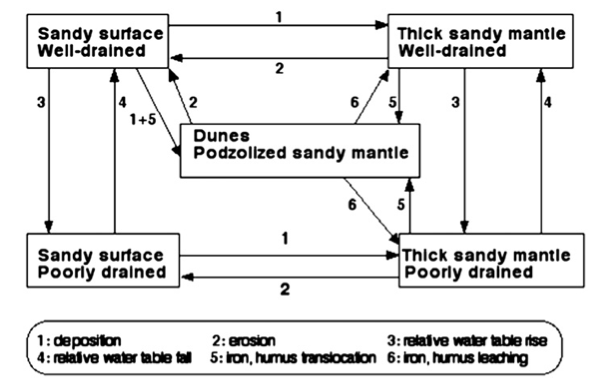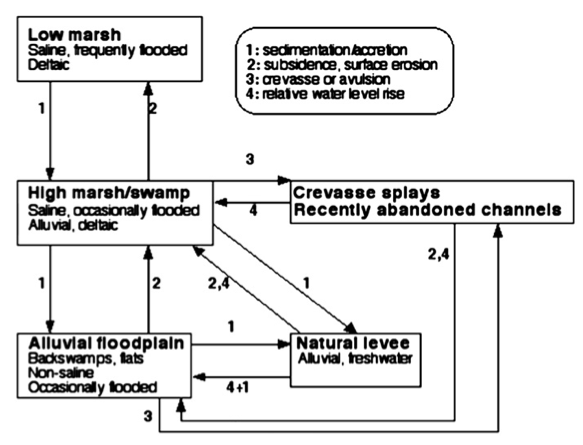This is a continuation of my earlier post on applying state-and-transition models (STM) to stratigraphic information, to account for the missing bits.

Barrell’s (1917) explanation of how oscillatory variations in base level control the timing of deposition. Sedimentation can only occur when base level is actively rising. These short intervals are indicated by the black bars in the top diagram. The resulting stratigraphic column, shown at the left, is full of disconformities, but appears to be the result of continuous sedimentation. Noted sedimentologist Andrew Miall has used this example in several articles to illustrate the problems of gaps in sedimentary & stratigraphic records.
A stratigraphic record of paleoenvironments, for instance, indicates a number of different states. For example, a transgressive coastal sequence might have facies indicating nearshore, beach, dune, back-barrier, estuary, and freshwater swamp environments. These would represent the states in the STM, which are considered connected if one state can transition directly to another, with no intermediate states. Assuming for the moment a high degree of confidence in the STM, suppose one was faced with a sequence of beach sand overlying freshwater swamp peat. The STM could tell you whether such a transition was possible or likely, or whether intermediate states such as backbarrier marsh or open-water estuary must have existed, but are not preserved in the record.
How does one build stratigraphic STMs? STMs applied to problems in contemporary environmental change are based on a combination of monitoring, observation, historical reconstruction, modeling, and theory. For stratigraphic STMs, once reasonable states are identified, we might use a hierarchy of evidence to establish whether transitions can occur from state A to state B.
1. Theoretical plausibility. Given our knowledge of applicable laws and principles, is it (a) plausible, and (b) likely, that the AàB transition could occur. In many cases this can be explored via simulation models.
2. Stratigraphic evidence. If AàB can happen, then there should exist stratigraphic evidence (ideally in multiple samples) that this has occurred.
3. Observational evidence (modern analogs). The strongest form of support is field measurements or observations that the transition has occurred.
A good STM not only records what transitions are possible, but what causes or drives them. In the example below, for instance, specific geomorphic and pedologic processes are identified that drive the soil changes depicted.

Soil geomorphic state transition model for an agricultural landscape in the N.C. coastal plain (from Phillips, 2014).
OK, now suppose you have a sedimentary sequence that shows low marsh overlying alluvial crevasse splays, and your interpretation is guided by the STM shown below (which I have high confidence in, because I developed it!). This shows that in this environment, you cannot transition directly from crevasse splay to low marsh, and indicates that at least one intermediate stage is missing. The STM also indicates that, because of the various, interactive drivers of state changes in this system, the sequence one would expect if, say, only sea-level rise or increased sediment inputs were driving the system may not exist. But the absence of the sequence doesn’t necessarily mean the driver is absent!

STM for geomorphic environments in the San Antonio River Delta, Texas (from Phillips, 2014).
The STM framework is not a revolutionary technique for solving stratigraphic puzzles. Rather, it is a way of thinking about and analyzing environmental change that may be helpful to stratigraphers. In addition, this conceptual model is amenable to the analytical tools of graph and network theory, which could provide paleoenvironmental analysis with a new set of quantitative tools (see this previous post).
--------------------------------------------
Barrell, J. 1917. Rhythms and the measurement of geologic time. Geological Society of America Bulletin, 28: 745-904.
